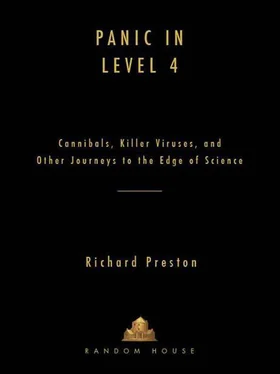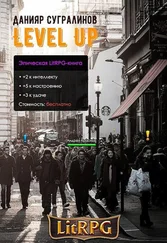The researchers’ names will be given here as Martha and Jeremy; those are not their real names.
Jeremy glanced at Martha. “I was thinking it might be a good day for going into BL-4,” he said.
“I was thinking so, too,” she answered. She was looking at me.
Jeremy turned to me and said, casually, “Are you up for BL-4 today?”
We were standing before an inconspicuous door marked AA-5. It led to one of the Ebola suites, a group of rooms where Ebola research was actively being done. “What will we be doing in there?” I asked.
“Somebody died,” Jeremy answered ominously. “The blood samples came in the other day. We’re doing tests to try to identify any virus in the samples.”
The dead person’s identity had not been disclosed to the Army researchers. They had been told he was a “John Doe” male. He had apparently been a U.S. government employee. He might have been a soldier. Or he might have been a diplomat. Or, possibly, John Doe had worked for an intelligence agency such as the CIA. The researchers would never learn his name, the circumstances of his death, where he had died, or who his employer had been.
The Institute had relationships with various U.S. government agencies and offices. They were known as clients. The Institute’s clients included the White House, the Department of Defense, and, almost certainly, a number of intelligence agencies. The Institute performed research for its clients. Whichever client John Doe had worked for, he had died with symptoms that suggested a hot virus. His death had apparently involved tiny, starlike pools of blood under his skin, and blood might have been flowing from his orifices.
“I don’t know where the samples came from,” Jeremy said. “They didn’t tell me. Maybe the Middle East. The X virus, if it’s there, seems to be Marburg-like.”
Marburg virus is a type of Ebola that is associated with Kitum Cave, in the rain forest on the eastern side of Mount Elgon, an extinct volcano in East Africa. On at least two occasions, people who went inside Kitum Cave died shortly afterward of Marburg virus, having apparently caught the virus inside or near the cave.
“If there’s a virus in the blood samples, it’s considered a Biosafety Level 4 agent,” Jeremy continued. “This is because the guy died and because it [the putative X virus] hasn’t been identified. It’s an Unknown,” he said.
Martha swiped her ID card across a sensor, and a computer-synthesized voice issued from a speaker by the door: “RTU downloading.” There was a chime. “One moment please,” the computer said. A green light went on, and there was a click. The entry door had unlocked.
Martha went through the entry door and closed it behind her. The light over the door went from green to red.
Meanwhile, Jeremy and I waited in the corridor. Beyond the door was a locker room. Martha would take off all her clothing in the locker room and then would proceed inward through some other rooms, where she would put on her space suit and head into the Ebola zone.
In a few minutes, the light turned green again. This meant that Martha had left the locker room and had gone farther inward. Now we could enter.
Jeremy swiped his security card on a pad by the door, I swiped mine, and we entered the locker room. As we went into the room, we passed through an additional security system that won’t be described here.
In the end, I never found out what role the commander had in my visit to Level 4. But I think he must have known about it. Jeremy and Martha were experienced, cautious professionals with impeccable safety records. I speculated that the commander had decided to permit me to visit Level 4 with these two people, so long as the visit was kept low-key—though not unofficial. The main building of USAMRIID had security guards who sat in a control room, monitoring the movements of people in the building. I guessed that the security people had known that I would be going into a hot zone even before I knew it myself. The magnetic security card that I wore clipped to my shirt could show the security staff my location in the building; it would also tell them that I was entering the hot area.
The locker room was small and gritty-looking, with a wooden bench and some steel gym lockers, banged up and dented. Jeremy and I stripped down to nothing and put our clothing in the lockers.
“You need to take off your glasses and leave them, too,” he said. “They’d fog up inside the suit, anyway.”
People had to take out contact lenses, as well. They also had to remove jewelry, including engagement rings. (Women were allowed to wear a tampon in Level 4, but they had to remove it on their way out of the lab.)
I put my glasses in the locker. As I took off my shirt, I slipped the notebook out of my pocket, and I clipped the mechanical pencil to the notebook. Holding these two items, but otherwise stark naked, I followed Jeremy through a doorway that led inward.
The doorway was actually a tiled shower stall, with a water shower-head in it and a drain in the floor. The shower stall glowed deep purple with ultraviolet lights. On their way out of the hot zone, after having worked in a space suit with dangerous organisms, the researchers would pass naked through the water shower, washing their skin with detergent and bathing their bodies in ultraviolet light, before they went into the locker room to get dressed.
On the inward side of the ultraviolet doorway was a small room considered to be at Biosafety Level 2—the mildest degree of biocontainment. Some metal shelves stood against one wall, and there was a toilet. The shelves were piled with blue cotton surgical scrub suits and other items of surgical wear, along with rolls of tape. We put on scrubs—no underwear was allowed. We also put on white socks, surgical hair coverings, and surgical gloves. Jeremy showed me how to tape the socks and the gloves to the cuffs of my scrub suit, wrapping the tape around the cuff to make a seal. “It’s a good idea to empty your bladder,” Jeremy said. “You won’t get a chance to once you’re in a suit.”
I took up my notebook and pencil, and we pushed through a door into Level 3—this was a staging area leading to Level 4. It was a large room with cinder-block walls and a concrete floor. We heard a rumble of air-filtering machinery overhead. The staging area was crowded with pieces of laboratory equipment. Along the left-hand wall hung an array of biohazard space suits. They were made of soft blue plastic, with flexible plastic helmet hoods. Most of the suits had the owners’ names written on them with a Magic Marker.
“People are touchy about their suits,” Jeremy remarked. “It’s like the Three Bears: ‘Somebody’s been wearing my suit.’”
Martha had already donned her space suit, and she was preparing things in the staging area. While Jeremy got into his suit, Martha took a space suit down from the wall and helped me put it on. She opened the suit, peeling apart a sort of large Ziploc-style zipper that ran across the chest, and handed the opened suit to me.
There was no name on my space suit.
I sat down on a bench and slipped my feet through the chest opening, down into the suit’s legs. My feet ended up inside a pair of soft plastic bunny feet attached to the suit’s legs. I drew the suit over my body, and slid my arms into the sleeves, and into heavy rubber gloves attached to the ends of the sleeves.
I pulled the hood and faceplate down over my head. The space suit’s zipper ran diagonally across the chest. I sealed the zipper, running my thumb and fingers along the seal, which closed me into the suit. The zipper was coated with a kind of grease that felt like Vaseline. The seals made a lip-smacking sound as I squeezed the zipper shut.
A number of bright yellow air hoses dangled from the ceiling. They were the source of clean air for people’s space suits. Each room in the hot zone had its own set of air hoses hanging from the ceiling. When you moved from one room to another, you had to detach your air hose and get connected to a different air hose in the new room.
Читать дальше








![Shin_Stark - В подземелье я пойду, там свой level подниму X [СИ]](/books/384602/shin-stark-v-podzemele-ya-pojdu-tam-svoj-level-po-thumb.webp)



